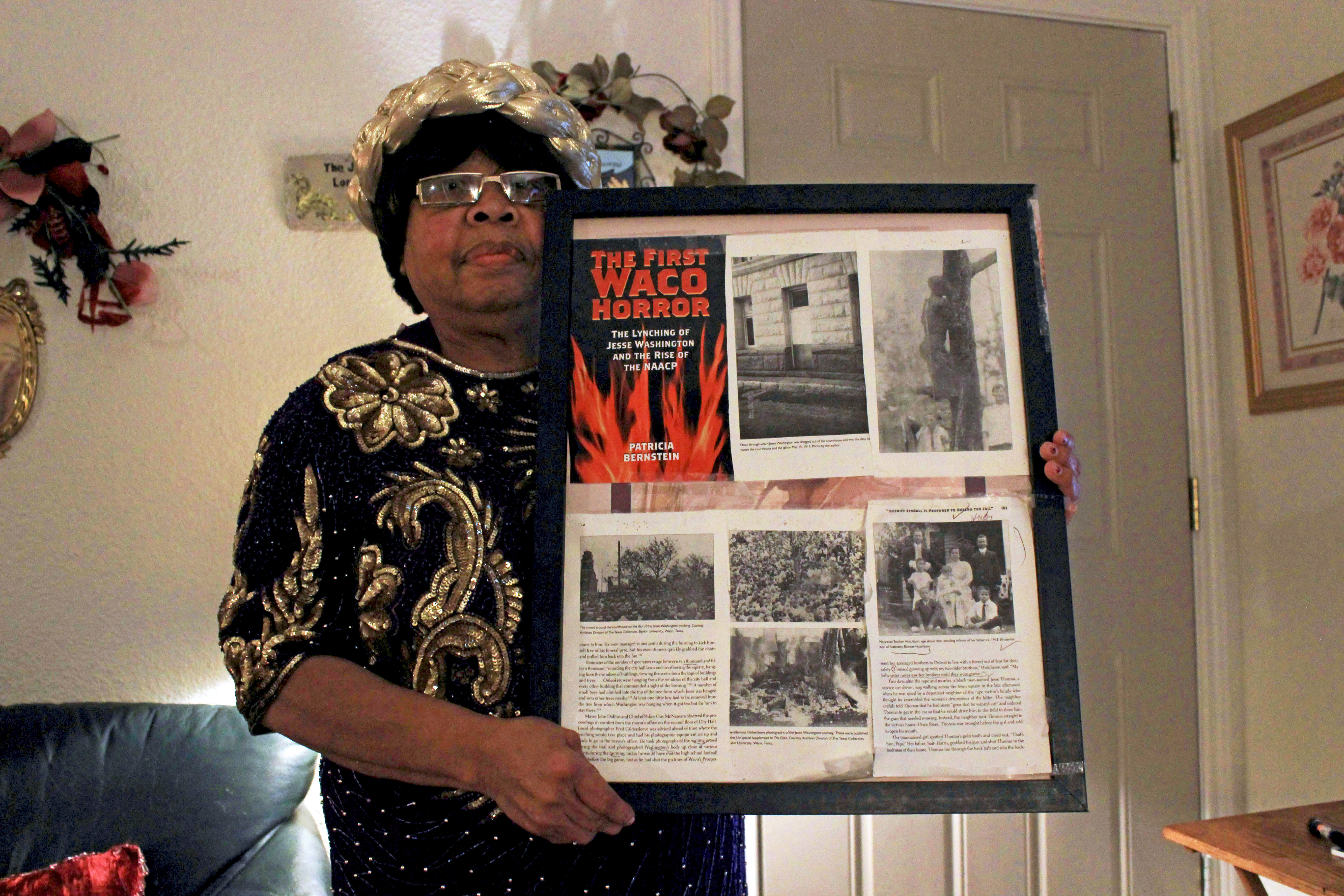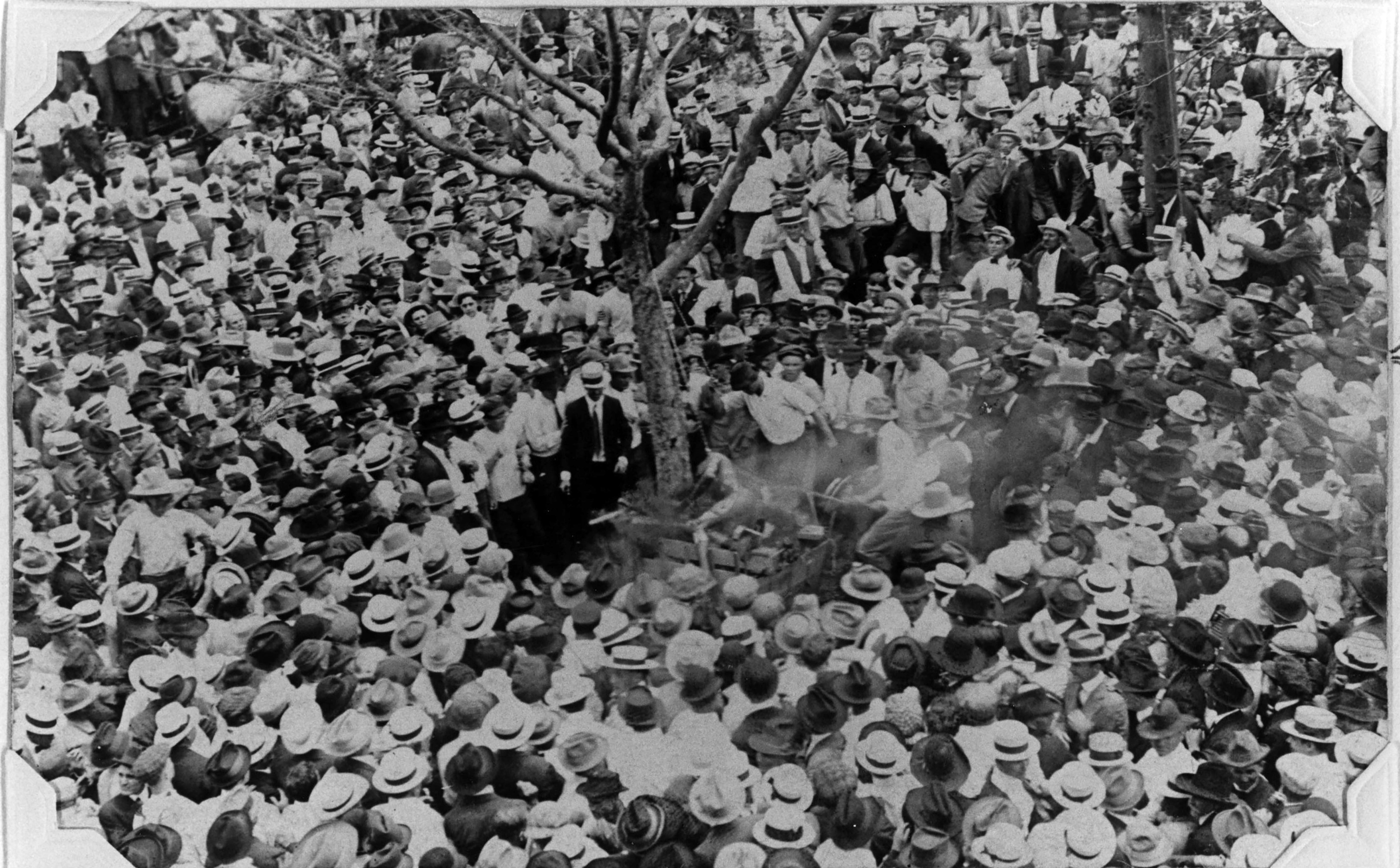 Story by Pablo Gonzales; Photos by Rachel Leland
Story by Pablo Gonzales; Photos by Rachel Leland
As a farmhand on the Fryer farm, Washington was responsible for plowing the fields and sowing cottonseeds. He worked tirelessly to do his best so that he could bring money home to his family who lived in a cabin on the property.
On the evening of May 8, 1916, Washington was out working in the cotton fields when he went into the Fryer home for some more cottonseeds. George Fryer was out in the fields working with his children. When Washington entered the house, Lucy Fryer reprimanded him for beating the mules in the field. He knocked her down and hit her with a blacksmith’s hammer. To avoid suspicion, he hid and abandoned the body and returned to his work, according to the Crisis report.
When the body was discovered, Washington was immediately named the first suspect. He was arrested and taken to the local jail in Waco. He was moved when word of a town mob from Robinson formed and they were looking for Robinson to torment him. He was moved from county jail to county jail for protection. While in custody, he confessed to killing Mrs. Fryer. He was even moved to Dallas for holding in the Dallas County Jail. It wasn’t until midnight on Monday, May 15 that Washington would be transported back to Waco for his trial.
Washington was escorted down the long marble hallway toward the courtroom. Fifteen hundred people were stuffed into the room, which was built to accommodate 500 people, according to the Crisis report.
The trial did not last long. There were so many people packed into the old courtroom that the jury could barely get in and out of their seats. In fact, one of the jurors was a convicted murder whose sentence was suspended in time for him to serve as a juror for this trial. Conveniently, a space was made for exit through a peculiar back door that led to the back alley behind the courthouse. Without any evidence, at approximately 11:22 a.m., the jury announced that they found Washington guilty of all charges.
Suddenly, the crowd charged Washington and tackled him. NAACP reporter Elisabeth Freeman conveys Washington’s final hours in depth. A chain was placed round his neck. He was stripped of his clothes and dragged out of the courtroom through the back door and into the street. The chain was tied to an automobile, but later it broke. “The big fellow took the chain of the Negro under the cover of the crowd and wound it around his own wrist, so that the crowd jerking at the chain was jerking at the man’s wrist and he was holding the boy,” Freeman reported. “The boy shrieked and struggled.” He was dragged through downtown Waco; his skin was slowly scraped off of his torpid body as he was tossed to and fro on the cobblestone streets. He was led to the square outside the City Hall and taken to a large tree where his chain was tied. There was a roaring fire ablaze at the base of the tree. His body was lowered and raised countless times into the fire by the mob. He was stabbed and beaten; he was nothing more than a charred corpse by the time the act was done.
Nothing was done to stop the lynching. In the distance, the towers of Old Main and Burleson Hall at Baylor University stood alone in the skyline. Pieces of his body were sold and his remains were left on display for several days. His lifeless body swung to and fro in the Central Texas wind.
For some, Waco serves as a reminder that there is indeed hatred that looms in the shadows and is taught from generation to generation. For Mary Pearson, whose grandmother was Washington’s cousin, Waco still reminds her of the tragedy that her family endured.
“When I think about how that young man was treated, I have moved beyond being angry. It depresses me,” Pearson said. “No human being should be treated in that way regardless of what they have done. But when I talk about what happened to my cousin, I find healing and restoration.”
Pearson lives in Robinson and has lived in the greater Waco area all of her life. While attending segregated schools, Pearson saw first-hand the ramifications of bigotry and hatred on a community.
Pearson recalls living in the Jim Crow era, walking into drugstores with her friends and being denied service. She can recall hearing the stories of Washington from her grandmother. The children in the family grew up in the shadow of the stories of Washington and were taught that what happened to him could easily happen to them.
“I want to take something bad and turn it into something good,” Pearson said.
As Waco grows, city and community leaders have worked together to make others aware of the horror that was done. In the McLennan County Courthouse, a mural on the ground floor tells a visual history of Waco. One of the panels of the mural depicts a tree with a noose.
As controversial as it seems, the city of Waco has issued a public proclamation addressing the history of lynching in McLennan County. The city is ashamed of its past, but they leave the mural on display to serve as a reminder of the impact that racial violence has had on the culture and history of McLennan County.
“It had to take the story of Jesse Washington for attention to be brought toward the issue,” Pearson said.
The history and legacy of stories like Washington’s are felt throughout the city of Waco. These stories of Waco in a different time serve to remind the city of its past.
“I have been reluctant to talk about the story, but I want to prove that Waco could be better,” Pearson said. “Everyone needs to know what Jesse faced is still an issue today.”
The same streets that Washington was dragged onto remain marked with the stamp of time. The city of Waco has taken steps to recognize the legacy of lynchings, but many feel that much more could be done. For example, the McLennan County Historical Commission voted in February 2016 to establish a historical marker commemorating Washington’s lynching.
“The tree he was hung on still stands in Heritage Square,” Pearson said. “People walk by it every day without knowing what happened.”
With the growth of Waco and Central Texas, civic leaders and civilians alike have worked to continue to bring light to the history and legacy of lynchings and other acts of injustice. Pearson hopes that by telling her family’s story, the next generation will learn from the mistakes of the past.
“I will continue to share this story to anyone who listens,” Pearson said. “My family will pass this story down as a legacy of what was and still is, and one day, justice will fall like rain.”

